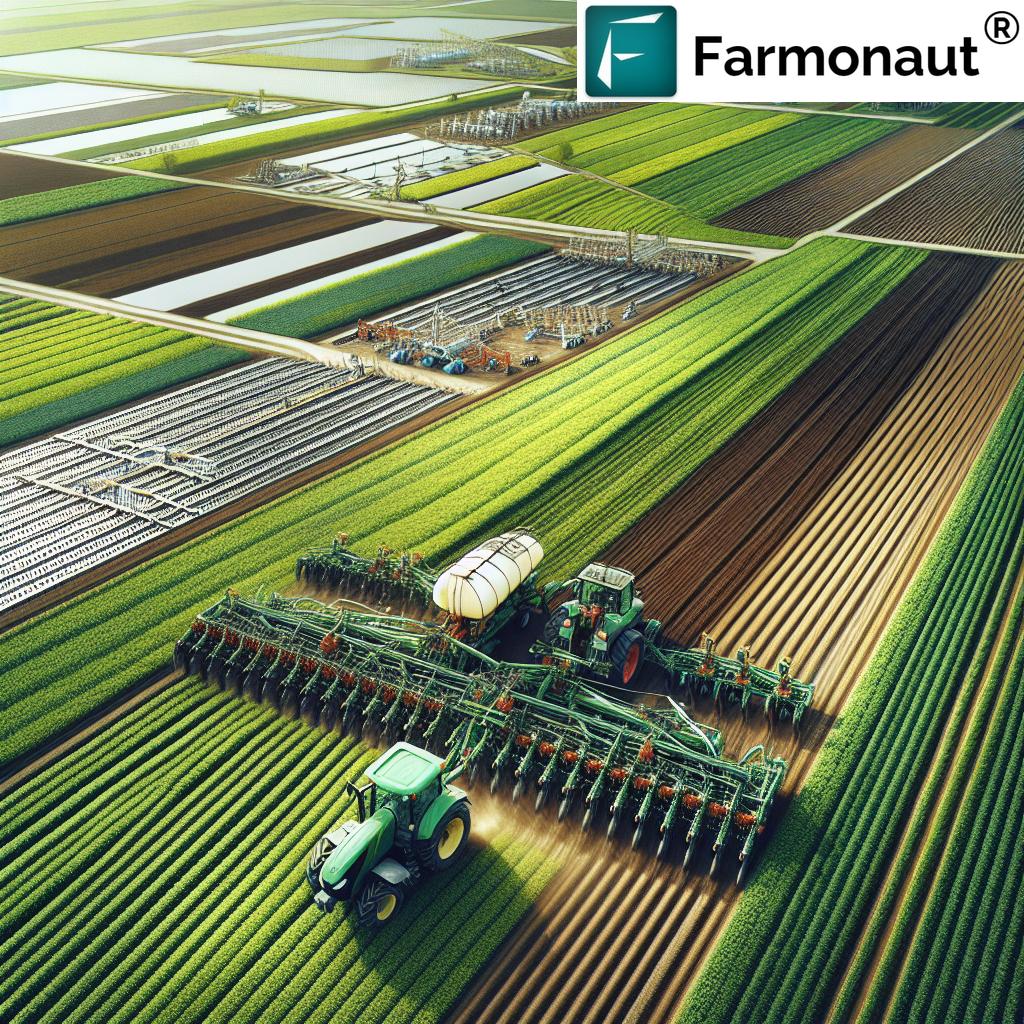Revolutionizing Farming: The Rise of Electric Utility Tractors with Autonomous Features
“Electric utility tractors with 110-kWh lithium-ion batteries can operate for up to 8 hours on a single charge.”
In the ever-evolving world of agriculture, we are witnessing a remarkable transformation that promises to reshape the future of farming. At the forefront of this revolution are electric utility tractors equipped with autonomous features, ushering in a new era of sustainable agriculture solutions and precision farming technology. As we delve into this groundbreaking topic, we’ll explore how these innovative machines are set to redefine the agricultural landscape, offering farmers unprecedented efficiency, sustainability, and technological advancement.
The Dawn of Electric Farm Vehicles
The agricultural industry has long relied on traditional diesel-powered tractors, but the tide is turning. Electric utility tractors are emerging as a game-changing alternative, offering a host of benefits that align with the growing demand for eco-friendly farm equipment and energy-efficient solutions. These smart tractors are not just a nod to environmental consciousness; they represent a leap forward in agricultural machinery innovations.
Let’s take a closer look at some of the key features that make these electric farm vehicles stand out:
- Power and Performance: With a robust 74 horsepower output, these tractors deliver impressive performance that rivals their diesel counterparts.
- Battery Capacity: A 110-kWh lithium-ion battery powers these machines, providing sustained energy for long working hours.
- Runtime: Farmers can enjoy up to eight hours of continuous operation on a single charge, ensuring productive workdays.
- Charging Efficiency: Fast charging capabilities mean less downtime and more field time for operators.
These features collectively contribute to a new standard in farming machinery, offering continuous torque and smooth operations that enhance overall productivity.
[Image 1: Electric utility tractor in a field]
Smart Tractor Features: Beyond Electric Power
What truly sets these electric utility tractors apart are their smart features and autonomous capabilities. These aren’t just vehicles; they’re sophisticated farm management tools designed to optimize every aspect of field operations.
“Smart tractors with 74 horsepower output feature advanced autonomous modes like Follow Me and 360 Degree Awareness.”
Let’s explore some of the cutting-edge features that are revolutionizing the way we approach farming:
- Follow Me Mode: This innovative feature allows the tractor to automatically follow the operator or another vehicle, streamlining operations like harvesting or planting.
- 360 Degree Awareness: Advanced sensors provide a comprehensive view of the tractor’s surroundings, enhancing safety and precision in tight spaces.
- Over the Air Updates: Just like your smartphone, these tractors can receive software updates remotely, ensuring they’re always equipped with the latest features and improvements.
- Connectivity Options: Integration with farm management systems allows for real-time data sharing and analysis, supporting informed decision-making.
These smart tractor features represent the convergence of agricultural expertise and cutting-edge technology, paving the way for more efficient and precise farming practices.
Precision Farming Technology: A New Era of Efficiency
The incorporation of precision farming technology in these electric utility tractors marks a significant leap forward in agricultural practices. By leveraging advanced sensors, GPS technology, and data analytics, these machines offer unprecedented accuracy in various farming operations.
Key aspects of precision farming enabled by these tractors include:
- Variable Rate Application: Optimizing the use of seeds, fertilizers, and pesticides based on soil conditions and crop needs.
- Automated Steering: Ensuring straight lines and reducing overlap, leading to more efficient use of land and resources.
- Yield Mapping: Collecting data on crop yields to inform future planting decisions and improve overall farm productivity.
- Soil Sampling and Analysis: Providing detailed insights into soil health to guide nutrient management strategies.
These capabilities not only enhance efficiency but also contribute to more sustainable farming practices by minimizing waste and optimizing resource use.
[YouTube Video: How Farmonaut’s Satellite Technology is Revolutionizing Land Use in Agriculture]
Sustainable Agriculture Solutions: Environmental Impact
One of the most compelling aspects of electric utility tractors is their potential to significantly reduce the environmental footprint of farming operations. As we strive for more sustainable agriculture solutions, these machines offer several key benefits:
- Zero Emissions: Unlike their diesel counterparts, electric tractors produce no direct emissions during operation, contributing to cleaner air and reduced carbon footprint.
- Noise Reduction: The quiet operation of electric motors means less noise pollution, creating a more pleasant working environment and reducing disturbance to wildlife.
- Energy Efficiency: Electric motors are inherently more efficient than internal combustion engines, converting a higher percentage of energy into usable work.
- Reduced Dependence on Fossil Fuels: By relying on electricity, which can be generated from renewable sources, these tractors help decrease the agriculture sector’s reliance on non-renewable resources.
These environmental benefits align with growing global initiatives to combat climate change and promote sustainable farming practices.
Practical Applications Across Agricultural Sectors
The versatility of electric utility tractors with autonomous features makes them suitable for a wide range of agricultural applications. From arable farming to forestry, these machines are proving their worth across various sectors:
- Arable Farming: Precision planting, tilling, and harvesting in crop fields.
- Livestock Management: Efficient feed distribution and pasture maintenance.
- Forestry: Navigating through woodlands for logging and forest management tasks.
- Horticulture: Precise operations in orchards and vineyards.
- Conservation Projects: Supporting environmental restoration and land management initiatives.
The adaptability of these tractors to different terrains and tasks showcases their potential to revolutionize multiple facets of the agricultural industry.
[YouTube Video: Farmonaut’s Advanced Agri Solutions: Precision Crop Area Estimation – Egypt Case Study]
Digital Agriculture Trends: Connectivity and Data-Driven Farming
The integration of electric utility tractors into the broader landscape of digital agriculture represents a significant trend in the industry. These machines are not isolated units but part of a connected ecosystem that leverages data to drive decision-making and improve overall farm management.
Key aspects of this digital integration include:
- IoT Connectivity: Tractors can communicate with other farm equipment and management systems, creating a network of smart devices.
- Data Collection and Analysis: Continuous monitoring of operations provides valuable insights for optimizing farm productivity.
- Predictive Maintenance: AI-driven systems can anticipate equipment needs, reducing downtime and extending machine life.
- Integration with Farm Management Software: Seamless connection with platforms that handle everything from crop planning to financial management.
This level of connectivity and data utilization is transforming farming from a traditionally intuitive practice to a highly data-driven and precise science.
Comparative Analysis: Electric vs. Traditional Tractors
To fully appreciate the impact of electric utility tractors, it’s essential to compare them directly with traditional diesel models. The following table provides a comprehensive overview of key features and capabilities:
| Features | Electric Utility Tractor | Traditional Diesel Tractor |
|---|---|---|
| Power Output | 74 horsepower | Varies (comparable models) |
| Battery Capacity | 110-kWh lithium-ion | N/A |
| Runtime | Up to 8 hours | Depends on fuel tank size |
| Charging Time | Fast charging available | Instant refueling |
| Autonomous Capabilities | Follow Me, 360 Degree Awareness | Limited or none |
| Environmental Impact | Zero direct emissions | Significant emissions |
| Connectivity Options | Advanced IoT integration | Limited in older models |
| Torque Delivery | Continuous, smooth | Variable, with gear changes |
| Maintenance Needs | Lower (fewer moving parts) | Higher (complex engine) |
| Noise Level | Very low | High |
This comparison highlights the significant advantages that electric utility tractors offer in terms of environmental impact, operational efficiency, and technological capabilities.
[Image 2: Comparison of electric and diesel tractors]
The Role of Autonomous Features in Enhancing Farm Safety
Safety is a paramount concern in agriculture, and the autonomous features of electric utility tractors are making significant strides in this area. These advanced systems not only improve efficiency but also contribute to a safer working environment for farm operators.
Key safety enhancements include:
- Obstacle Detection: Advanced sensors can identify and avoid potential hazards in the field.
- Fatigue Reduction: Autonomous operation reduces the physical strain on operators during long working hours.
- Precision in Hazardous Conditions: Autonomous features allow for accurate operation in low-visibility situations or on challenging terrain.
- Remote Operation: Some tasks can be performed without an operator in the cab, reducing exposure to potentially dangerous situations.
These safety features represent a significant leap forward in protecting farm workers and reducing accidents in agricultural settings.
[YouTube Video: Farmonaut: Cultivating Innovation in Agriculture | Year in Review 2023]
Economic Implications for Farmers and Agribusinesses
The adoption of electric utility tractors with autonomous features has significant economic implications for the agricultural sector. While the initial investment may be higher than traditional tractors, the long-term benefits can lead to substantial cost savings and increased profitability.
Economic advantages include:
- Reduced Fuel Costs: Electricity is generally cheaper than diesel, leading to lower operational expenses.
- Lower Maintenance Costs: Electric motors have fewer moving parts, resulting in reduced maintenance needs and downtime.
- Increased Productivity: Autonomous features and precision technology lead to more efficient use of time and resources.
- Potential for Government Incentives: Many regions offer subsidies or tax breaks for adopting eco-friendly agricultural equipment.
- Extended Working Hours: The quiet operation of electric tractors allows for work during early morning or late evening hours without disturbing neighbors.
These economic factors make electric utility tractors an increasingly attractive option for forward-thinking farmers and agribusinesses looking to optimize their operations and boost their bottom line.
The Future of Farming: Integration with Renewable Energy
As we look to the future, the potential for integrating electric utility tractors with renewable energy sources presents an exciting prospect for sustainable agriculture. This synergy could lead to farms that are not only productive but also energy-independent.
Potential developments include:
- Solar-Powered Charging Stations: On-farm solar installations could provide clean energy to power electric tractors and other equipment.
- Wind Energy Integration: Farms in windy areas could harness this resource to generate electricity for their operations.
- Biogas Utilization: Agricultural waste could be converted into biogas to power electric generators for charging tractors.
- Smart Grid Technologies: Advanced energy management systems could optimize the use of renewable energy across all farm operations.
These innovations point towards a future where farms become net energy producers, contributing to a more sustainable and resilient agricultural sector.
[YouTube Video: The Role of Artificial Intelligence in Agriculture – Farmonaut | Agritecture | Joyce Hunter]
Challenges and Considerations
While the potential of electric utility tractors with autonomous features is immense, there are several challenges and considerations that farmers and manufacturers must address:
- Infrastructure Development: Adequate charging infrastructure needs to be established in rural areas.
- Battery Technology: Ongoing research is needed to improve battery life and reduce charging times.
- Initial Costs: The higher upfront investment may be a barrier for some farmers, necessitating financial support or new business models.
- Training and Education: Farmers and operators need to be trained in the use of these advanced technologies.
- Regulatory Framework: Governments need to develop appropriate regulations for autonomous vehicles in agricultural settings.
Addressing these challenges will be crucial for the widespread adoption and success of electric utility tractors in the agricultural sector.
Conclusion: Embracing the Agricultural Revolution
The rise of electric utility tractors with autonomous features marks a significant milestone in the evolution of agriculture. These innovative machines embody the convergence of sustainable agriculture solutions, precision farming technology, and digital agriculture trends. As we’ve explored throughout this article, the benefits of these tractors extend far beyond environmental considerations, touching on aspects of efficiency, safety, and economic viability.
For farmers and agribusinesses looking to stay at the forefront of agricultural innovation, embracing these technologies will be key to remaining competitive in an ever-changing landscape. The journey towards fully integrated, sustainable, and high-tech farming is well underway, and electric utility tractors are leading the charge.
As we look to the future, it’s clear that the agricultural sector is on the cusp of a technological revolution that promises to make farming more sustainable, efficient, and productive than ever before. The rise of electric utility tractors with autonomous features is not just a trend; it’s a glimpse into the future of farming – a future that’s cleaner, smarter, and more connected.
FAQs
- Q: How do electric utility tractors compare to traditional diesel tractors in terms of power?
A: Electric utility tractors, such as those with 74 horsepower output, can match or exceed the power of comparable diesel models while offering continuous torque and smoother operation. - Q: What is the typical runtime for an electric utility tractor?
A: With a 110-kWh lithium-ion battery, these tractors can operate for up to 8 hours on a single charge, suitable for most daily farming tasks. - Q: Are electric tractors suitable for all types of farming?
A: Electric utility tractors are versatile and can be used in various agricultural sectors, including arable farming, livestock management, forestry, and horticulture. - Q: What are the main environmental benefits of using electric tractors?
A: Electric tractors produce zero direct emissions, reduce noise pollution, and can be powered by renewable energy sources, significantly lowering the environmental impact of farming operations. - Q: How do autonomous features enhance farming operations?
A: Autonomous features like Follow Me mode and 360 Degree Awareness improve efficiency, precision, and safety in various farming tasks, reducing operator fatigue and optimizing resource use.
For more information on innovative agricultural technologies and satellite-based farm management solutions, visit Farmonaut’s web application. Our platform offers advanced crop health monitoring, AI-based advisory systems, and resource management tools to help you optimize your farming operations.
Interested in integrating satellite and weather data into your own systems? Check out our API and API Developer Docs for more information.
Download our mobile apps for on-the-go farm management:















